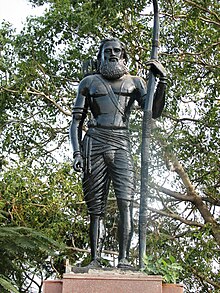Alluri Sitarama Raju | |
|---|---|
 Alluri's statue at the Tank Bund Road | |
| Born | 4 July 1897 or 1898 |
| Died | 7 May 1924 (aged 25 or 26) |
| Cause of death | Summary execution |
| Resting place | Krishnadevipeta, Andhra Pradesh, India |
| Known for | Rampa Rebellion of 1922 |
| Title | Manyam Veerudu |
Alluri Sitarama Raju (4 July 1897 or 1898 – 7 May 1924) was an Indian revolutionary who waged an armed rebellion against the British colonial rule in India. Born in present-day Andhra Pradesh, he was involved in opposing the British in response to the 1882 Madras Forest Act that effectively restricted the free movement of adivasis in their forest habitats and prevented them from practicing their traditional form of agriculture called 'podu', which threatened their very way of life. Rise in discontent towards the British colonial rule in the backdrop of the non-cooperation movement (1920–1922) led to the Rampa rebellion (1922–1924) in which Alluri Sitarama Raju played the major role as its leader. Mustering combined forces of tribals and other sympathizers to the cause, he engaged in guerilla campaigns against the British forces across the border regions of present-day Andhra Pradesh and Odisha states in India.[a] He was given the title "Manyam Veerudu" (transl. Hero of the Jungle) by the local people for his exploits.[2]
Born into a Telugu family as Alluri Rama Raju, he prefixed the name "Sita" to his in memory of a girl whom he loved during his youth and whose untimely demise at a young age left him heartbroken. He later took up sannyasa at the age of 18 and grew to become a charismatic leader of the downtrodden tribal people in the 20th century colonial India. As the leader of the Manyam rebellion or the Rampa Rebellion of 1922, Alluri Sitarama Raju led his forces against the British colonial rulers with an aim of expelling them from the Eastern Ghats region in the erstwhile Madras Presidency. During the rebellion he led numerous raids on the imperial police stations to acquire firearms for his under-equipped forces. After each raid, he would leave a written note in the station signed by him informing the police about the details of his plunder there, including details of the weaponry he acquired daring them to stop him if they could.
Police stations in and around areas of Annavaram, Addateegala, Chintapalle, Dammanapalli, Krishna Devi Peta, Rampachodavaram, Rajavommangi, and Narsipatnam were all targeted by his forces, which resulted in significant police casualties. In response to these raids and to quell the rebellion, the British colonial authorities undertook a nearly two year long manhunt for Alluri Sitarama Raju that resulted in expenditures reaching over ₹4 million rupees. Eventually, in 1924, he was trapped at Koyyuru village in Chintapalle forests. There, he was captured, tied to a tree, and was summarily executed by a firing squad. A mausoleum with his final remains was built in the village of Krishnadevipeta in Andhra Pradesh.
Cite error: There are <ref group=lower-alpha> tags or {{efn}} templates on this page, but the references will not show without a {{reflist|group=lower-alpha}} template or {{notelist}} template (see the help page).